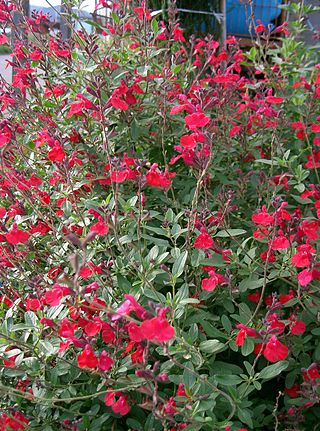
Geranium cinereum, the ashy cranesbill, is a species of flowering plant in the family Geraniaceae, native to the Pyrenees. Growing to 50 cm (20 in) tall and wide, it is a small, deciduous or semi-evergreen perennial usually grown for low ground cover, rockeries or underplanting larger subjects like roses. Leaves are deeply divided and grey-green – whence the Latin specific epithet cinereum "ash-grey". It flowers in summer, with striking black-eyed flowers with black stamens. The plant grows in full sunlight, and is hardy down to −15 °C (5 °F).

Sempervivum is a genus of about 40 species of flowering plants in the family Crassulaceae, commonly known as houseleeks. Other common names include liveforever and hen and chicks, a name shared with plants of other genera as well. They are succulent perennials forming mats composed of tufted leaves in rosettes. In favourable conditions they spread rapidly via offsets, and several species are valued in cultivation as groundcover for dry, sunny locations.

Chamaecyparis obtusa is a species of cypress native to central Japan in East Asia, and widely cultivated in the temperate northern hemisphere for its high-quality timber and ornamental qualities, with many cultivars commercially available.

Impatiens walleriana, also known as busy Lizzie, balsam, sultana, or simply impatiens, is a species of the genus Impatiens, native to eastern Africa from Kenya to Mozambique. The Latin specific epithet walleriana honours a British missionary, Horace Waller (1833–1896).

Echeveria is a large genus of flowering plants in the family Crassulaceae, native to semi-desert areas of Central America, Mexico and northwestern South America.

Hyacinthus orientalis, the common hyacinth, garden hyacinth or Dutch hyacinth, is a species of flowering plant in the family Asparagaceae, subfamily Scilloideae, native to southwestern Asia, southern and central Turkey, northwestern Syria, Lebanon and northern Palestine. It was introduced to Europe in the 16th century. It is widely cultivated everywhere in the temperate world for its strongly fragrant flowers which appear exceptionally early in the season, and frequently forced to flower at Christmas time.

Celosia argentea, commonly known as the plumed cockscomb or silver cock's comb, is a herbaceous plant of tropical origin in the Amaranthaceae family from India and Nepal. The plant is known for its very bright colors. In India and China it is known as a troublesome weed.

Plectranthus is a genus of about 85 species of flowering plants from the sage family, Lamiaceae, found mostly in southern and tropical Africa and Madagascar. Common names include spur-flower. Plectranthus species are herbaceous perennial plants, rarely annuals or soft-wooded shrubs, sometimes succulent; sometimes with a tuberous base.

Coleus argentatus, synonym Plectranthus argentatus, common name silver spurflower, is a species of flowering plant in the mint family. It is native to rock outcrops and rainforest in the border region of Queensland and New South Wales, Australia. Growing to 1 m (3 ft) tall and broad, it is a spreading deciduous shrub. The hairy leaves are ovate to broad-ovate, 5–11.5 cm long, 3–5.5 cm wide with crenate margins. The hairs give the plant an overall sage green to silvery colour. The flowers are borne on terminal racemes up to 30 cm (12 in) long, and are bluish white.

Salvia greggii, the autumn sage, is a herbaceous perennial plant native to a long, narrow area from southwest Texas, through the Chihuahuan Desert and into the Mexican state of San Luis Potosi, typically growing in rocky soils at elevations from 5,000 to 9,000 ft. It was named and described in 1870 by botanist Asa Gray after Josiah Gregg, a merchant, explorer, naturalist, and author from the American Southwest and Northern Mexico, who found and collected the plant in Texas. It is closely related to, and frequently hybridizes with, Salvia microphylla. Despite the common name "autumn sage", it blooms throughout the summer and autumn.

Coleus scutellarioides, commonly known as coleus, is a species of flowering plant in the family Lamiaceae, native to southeast Asia through to Australia. Typically growing to 60–75 cm (24–30 in) tall and wide, it is a bushy, woody-based evergreen perennial, widely grown for the highly decorative variegated leaves found in cultivated varieties. Another common name is painted nettle, reflecting its relationship to deadnettles, which are in the same family. The synonyms Coleus blumei, Plectranthus scutellarioides and Solenostemon scutellarioides are also widely used for this species.

Hakonechloa is a genus of bunchgrass in the tribe Molinieae of the grass family, Poaceae, native to eastern Asia.

Fittonia albivenis is a species of flowering plant in the family Acanthaceae, native to the rainforests of Colombia, Peru, Bolivia, Ecuador and northern Brazil. An evergreen perennial, it is notable for its dark green foliage with strongly contrasting white or red veins. It is commonly called nerve plant or mosaic plant. In temperate regions where the temperature falls below 10 °C (50 °F) it must be grown as a houseplant.

Ctenanthe oppenheimiana, the giant bamburanta or never-never plant, is a species of flowering plant of family Marantaceae and is a native of Brazil. It is an evergreen perennial. This plant can grow to more than 1 m (3.3 ft) tall and broad, with long narrow leaves up to 40 cm (16 in) in length. The leaves are adorned on the secondary veins with dark green bands, which meet and merge in the margins. In between are cream coloured bands. The undersides of the leaves have a red-ish colour. The cultivar 'Tricolor' is a common ornamental variety, which as a houseplant in the UK has gained the Royal Horticultural Society's Award of Garden Merit.. This cultivar is visually very similar to Stromanthe Sanguinea 'Triostar', and the two are often confused. The difference between the two lies in the lack of regular banding on the leaves of the Sromanthe, and the generally more rounded shape of the leaves in Ctenanthe.

Salvia microphylla, synonyms including Salvia grahamii, Salvia lemmonii and Salvia neurepia, the baby sage, Graham's sage, or blackcurrant sage, is an evergreen shrub found in the wild in southeastern Arizona and the mountains of eastern, western, and southern Mexico. It is a very complex species which easily hybridizes, resulting in numerous hybrids and cultivars brought into horticulture since the 1990s. The specific epithet microphylla, from the Greek, means "small leaved". In Mexico it is called mirto de montes, or "myrtle of the mountains".

Cercidiphyllum japonicum, known as the Katsura, is a species of flowering tree in the family Cercidiphyllaceae native to China and Japan. It is sometimes called caramel tree for the light caramel smell it emits during leaf fall.

Sempervivium calcareum, the houseleek, is a species of flowering plant in the stonecrop family Crassulaceae, native to the southern Alps in Europe. An evergreen succulent perennial, it has a rosette with thick leaves that store water. The leaves are usually green with reddish-purple tips. This plant reproduces with asexual budding and monocarpic sexual reproduction.

Ceratostigma willmottianum, Chinese plumbago, is a species of flowering plant in the family Plumbaginaceae that is native to western China and Tibet. It is an ornamental deciduous shrub that grows to 1 metre in height, with pale blue plumbago-like flowers appearing in autumn as the leaves start to turn red.

Plectranthus fruticosus, the forest spurflower, is a species of flowering plant in the mint family, Lamiaceae. It is native to Mozambique, Eswatini, and South Africa's KwaZulu-Natal, Northern, and Cape provinces. Growing up to 2 m (6.6 ft) tall, it is an erect evergreen shrub, with rounded, hairy leaves, and spikes of soft blue or mauve flowers in summer.

Elaeagnus × submacrophylla, formerly known as Elaeagnus × ebbingei, is a hybrid between Elaeagnus macrophylla and Elaeagnus pungens. Several cultivars, including 'Gilt Edge', are grown in gardens as ornamental plants. Both the hybrid and 'Gilt Edge' have gained the Royal Horticultural Society's Award of Garden Merit.




















